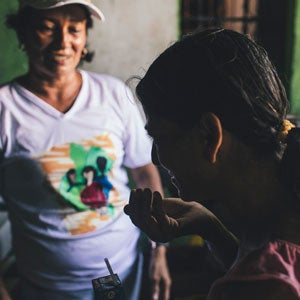
An estimated 50,000 people in the Americas have TB but do not know it.
Washington, D.C., March 23, 2017 (PAHO/WHO) - The countries of the Americas have dramatically reduced new cases and deaths from tuberculosis (TB) in the past 25 years. Despite this, nearly 270,000 people contracted the disease in 2015, and some 50,000 do not know they have it.
On World TB Day 2017, the Pan American Health Organization/World Health Organization (PAHO/WHO) is calling on governments, communities, civil society and the private sector to join efforts to end TB and leave no one behind.
"Tuberculosis is associated with poverty and poor living conditions, which, combined with the difficulties of access to health services, represents a problem that must be addressed by society as a whole," said Marcos Espinal, director of PAHO/WHO's Department of Communicable Diseases and Health Analysis.
The populations most at risk of TB in the Americas are people living with HIV, those who are homeless, urban slum dwellers, and people with addiction problems. These populations generally have limited access to health care or, if they do have access, are less likely to be promptly diagnosed as having TB.

This year, PAHO/WHO's World TB Day campaign has the slogan "Unite to end TB: Leave no one behind " and seeks to promote access to quality health care for people with TB. Currently, more than one in three people with TB worldwide lack access to good care.
The campaign promotes cross-sector action to prevent new TB cases by combating poverty, a major determinant of TB, and by improving diagnosis and treatment, promoting research and innovation, and ending stigma and discrimination, which are key barriers to accessing health care.
Ending TB is possible
The Region of the Americas accounts for only 2.6% of all new TB cases worldwide, compared with 61% in Asia and 26% in Africa. In the Americas, 88% of new TB cases are concentrated in 10 countries. The number of new cases in the region has declined by 1.8% annually since 2000, and the number of deaths by 2.9%, largely due to the implementation of measures recommended in WHO's global TB strategy and PAHO's Plan of Action for the Prevention and Control of TB. Nevertheless, efforts need to be stepped up to meet the goal of ending TB by 2030, as called for in the Sustainable Development Goals (SDGs).
"Ending tuberculosis is possible," said Mirtha Del Granado, PAHO/WHO's regional advisor on TB. She said efforts need to be focused on reaching the groups at highest risk, addressing social factors that influence health, and expanding access to quality diagnosis and treatment for all who need it.
New challenges
Although TB is a preventable and curable disease, it claimed an estimated 25,000 lives in the Americas in 2015. Immunocompromised people, such as those with HIV, malnutrition or diabetes, and tobacco users are among the groups at greatest risk of developing the disease. In 2015, 32,000 people with HIV developed TB in the region.
One of the major challenges for the fight against TB is the emergence of new strains that are resistant to medications that that have been used for decades to treat the disease. PAHO/WHO estimates that there were some 7,700 cases of multidrug-resistant tuberculosis in the Americas in 2015, of which 59% were diagnosed. Of these patients, only 75% are currently receiving effective treatment.
Links
- World Tuberculosis Day
- TB situation in the Americas (Spanish only)
- Ethics guidance for the implementation of the End TB strategy
- https://www.twitter.com/pahowho #EndTB



